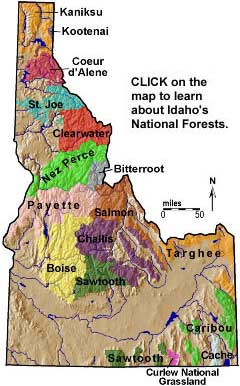 National Forests
National Forests
Introduction
Idaho is lucky to have so many beautiful forests. Almost
everyone loves the mountains and enjoys the trees and animals. Though we enjoy
the pleasures of the forests, the trees are valuable for other reasons as well.
The forests are most important because they are part of our watershed. They
help store snow and water, and control the amount of water in our streams and
rivers. The trees shade the snow and make it melt more slowly. Without shade,
the snow would melt too quickly. The tree roots hold the soil in place. Without
roots, the soil would wash away. The soft, spongy forest floor also stores some
of the water and lets it trickle clean and clear into the streams. Without the
trees, the water would run down the streams and rivers in a big, muddy rush.
There would be a huge, muddy spring flood, then no water later in the summer.
Idaho forests are important for another reason. They provide jobs and many of the things we use every day. Trees are used to make our houses, furniture, railroad ties, wooden boxes, wooden matches, rayon, and paper - among other things.
Native trees of the Panhandle and mountains of Idaho include aspens and needleleaf trees. These trees grow straight and tall. They are also known as evergreens. This means that these trees are green all year long and never lose all their leaves like broadleaf trees do. Several important kinds of needleleaf trees make up Idaho's forests. The most valuable is the western white pine. Idaho has the largest stand of white pine forest left in the United States. Its clear, straight grain makes it excellent for lumber and wooden matches. Next in value are the ponderosa or western yellow pine and the Douglas fir . These are excellent for lumber and timbers. Another interesting and valuable Idaho tree is the western red cedar. It is used for furniture, fence posts, telephone poles, and other uses. The largest living tree in Idaho is the red cedar growing in Land Board State Park near Elk River. It is sixteen feet through the trunk, and more than 150 feet tall. It is thought to be between 2,000 and 3,000 years old. This is nearly as old as the famous redwoods of California.